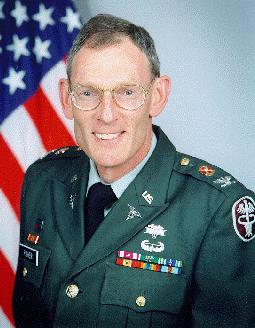


BA, Drexel Univ., Philadelphia, PA, 1970
MA, Drexel Univ., Philadelphia, PA, 1972
MHA, Baylor Univ., Waco, TX, 1983
Assoc. Director, New Mexico VA Health Care System, Albuquerque, New Mexico, 2004 to present
Manager, Samuel S. Stratton VAMC, Albany, NY, 2002-03
Dep. Commander Admin., Brooke AMC, Ft. Sam Houston, TX, 1999-2002
Commander, Army Garrison, Fitzsimmons, Aurora, CO, 1999
Dep. Commander Admin., Blanchfield ACH, Ft. Campbell, KY, 1994-99
Dep. Commander Admin., MEDDAC, Ft. Monmouth, NJ, 1990-94
Insp. Gen., Tripler AMC, HI, 1988-90
Chief, Clin. Spt. Div., Fitzsimons AMC, Denver, CO, 1986-88
Admin. Off., Dept. Med., Fitzsimons AMC, Denver, CO, 1984-86
Exec. Off., Med. Hosp. Combat Spt., Ft. Devens, MA, 1983-84
Resident, Ft. Devens, MA, 1982-83
In the late 1970’s, a position for an ESO was created at the Health Facilities Planning Agency in Washington, DC. The role of the incumbent was to review plans and designs to ensure that potential health hazards were being appropriately addressed during the initial project planning stages. I expressed an interest in the position to my consultant and let him know that I met the Baylor prerequisites. I convinced him that I would better be able to perform that job with a health care administration degree. He supported my application, and I was accepted into the program that began in September, 1981.
At the time of my enrollment, I had every intention of remaining an ESO and going to HFCA. However, as the program progressed, I developed a strong interest in health care administration. After completing an administrative residency at Fort Devens, MA (the last admin resident at that hospital), I served for a year as the XO of the 46th Combat Support Hospital, also at Fort Devens. During that period, I was funded to attend my first ACHE Congress. While in Chicago, I asked a number of officers if they knew of any upcoming hospital administrative officer openings. Someone told me to see COL Richard Meiers, the Fitzsimons Chief of Staff. I introduced myself, found out that he was looking for an admin officer in the Department of Medicine, and expressed an interest.
My introduction to Rich Meiers turned out to be a milestone in my professional life. For years afterward, Rich looked out for me. He helped my move from Medicine to CSD at Fitzsimons, and subsequently to the IG position at Tripler after his reassignment to Hawaii. Prior to his retirement, he was instrumental in my reassignment to Fort Monmouth, NJ, the first of my three DCA positions. He was my mentor and guardian angel, without whom I would have never progressed to the rank of Colonel and final assignment as the Chief of Staff, Brooke Army Medical Center, from which I retired on January 31, 2002.
I do not believe that I was ever as close to other people as I was to my Baylor classmates in 1981-82. We worked as a team, got along well, and pushed and pulled each other through. My seat mate was the infamous Shack Robinson, notorious womanizer and social animal. On many occasions, Shack spent the day next to me bleary eyed from the previous night’s revelry. He was a great guy, as were all the rest.
In retrospect, the most important concept that I learned from Baylor was the concept of systems thinking-looking at the big picture- how one action impacted on others. As a systems thinker, I have been much better able to forecast at the impact of process changes. Of course, systems thinking is also at the center of JCAHO’s performance improvement focus.
My background as a DCA and Commander (I am the answer to the never-asked trivia question, “Who was the last commander of Fitzsimons?”) provided me with plenty of achievements for a strong resume, and, in January, 2002, I was hired by the Veteran’s Health Administration as a careline manager at the Albany, New York VA Medical Center.
There is no way that I would have attained the positions in which I served without my Baylor background and the mentorship of Rich Meiers.
I should mention that also I served as an officer if the Baylor Alumni Club for several years, including a year as the group’s President in 1991. We had a great dinner that year, one of the last of the one-price, open bar dinners in Chicago. I remember that Tom Dolan, ACHE President, dropped by during the especially raucous happy hour and remarked to me that he had never before seen such spirit. That comment alone made my Presidency worthwhile.